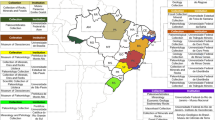Abstract
Digital Humanities projects have shown to be projects of collaboration and interdisciplinary cooperation. As digital humanities researchers are creating and discovering new methods of collaboration, libraries have been reflecting on how they can best support and nurture such collaborations. This paper aims to demonstrate a practical case of what the University of South Florida Digital Collections has done to support the accessibility and discoverability of a new archaeological dataset in collaboration with a Digital Humanities research facility on campus. This paper is a case study to showcase the process employed by the University of South Florida Libraries in its partnership with an on campus digital humanities institute in the creation of a new digital collection. The partnership resulted in a prototype archaeological data repository named the Andean Archaeological Data Project, and a digital collection that was successfully housed in the existing digital library platform, through which public access to the material is natively enabled through the library web pages. The authors have come to the conclusion that with the proper infrastructure and the appropriate skill sets, a digital library can be a long-term platform for dynamic digital humanities research data.







Similar content being viewed by others
References
Fay, E., Nyhan, J.: Webbs on the web: libraries, digital humanities and collaboration. Libr Rev 64(1/2), 118–134 (2015). https://doi.org/10.1108/LR-08-2014-0089
Wong, S.H.R.: Digital humanities: what can libraries offer? Portal Libr Acad 16(4), 669–690 (2016). https://doi.org/10.1353/pla.2016.0046
Ying Zhang, S.L.: Convergence of digital humanities and digital libraries. Libr Manag 36(4/5), 362–377 (2015). https://doi.org/10.1108/LM-09-2014-0116
OCHRE Data Service (2017) Accessed https://voices.uchicago.edu/ochre/
Sheehan, B.: Comparing digital archaeological repositories: tDAR versus open context. Behav Soc Sci Libr 34(4), 173 (2015). https://doi.org/10.1080/01639269.2015.1096155
Niccolucci, F., Richards, J.D.: ARIADNE: advanced research infrastructures for archaeological dataset networking in Europe. Int J Hum Arts Comput J Digit Hum 7(1/2), 70–88 (2013). https://doi.org/10.3366/ijhac.2013.0082
Shen, R., Vemuri, N.S., Fan, W., Fox, E.A.: Integration of complex archeology digital libraries: an ETANA-DL experience. Inf Syst 33(7), 699–723 (2008). https://doi.org/10.1016/j.is.2008.02.006
Schloen, J.D., Schloen, S.R.: OCHRE an online cultural and historical research environment. Eisenbrauns, Winona Lake, Indiana (2012)
About iDAI.objects arachne (nd) https://arachne.dainst.org/info/about
Institute of advanced study of culture and the environment. (2019). Accessed https://www.usf.edu/arts-sciences/institutes/iasce/
Data Durability and Reliability (2019) Accessed https://aws.amazon.com/glacier/features/?nc=sn&loc=2#Data_durability_and_reliability
Gasaway, L.N.: Copyright ownership & the impact on academic libraries. J Art Entertain Law 13, 277 (2003)
Mallalieu, R.: The elusive gold mine? The finer details of Creative Commons licenses—and why they really matter. Insights UKSG J 32, 1–7 (2019). https://doi.org/10.1629/uksg.448
Snijder, R.: Better sharing through licenses? Measuring the influence of creative commons licenses on the usage of open access monographs. J Librariansh Sch Commun 3(1), 1–21 (2015). https://doi.org/10.7710/2162-3309.1187
Clapham, P.: Are creative commons licenses overly permissive? The case of a predatory publisher. Bioscience 68(11), 842–843 (2018). https://doi.org/10.1093/biosci/biy098
Author information
Authors and Affiliations
Corresponding author
Additional information
Publisher's Note
Springer Nature remains neutral with regard to jurisdictional claims in published maps and institutional affiliations.
Rights and permissions
About this article
Cite this article
Mi, X., Bernardy, R. & Schmidt, L. Building an archaeological data repository: a digital library and digital humanities collaboration at the University of South Florida. Int J Digit Libr 22, 135–145 (2021). https://doi.org/10.1007/s00799-020-00297-1
Received:
Revised:
Accepted:
Published:
Issue Date:
DOI: https://doi.org/10.1007/s00799-020-00297-1




